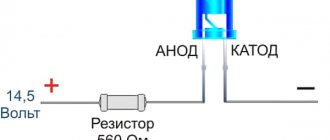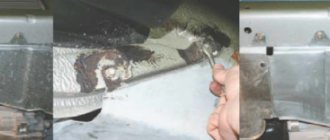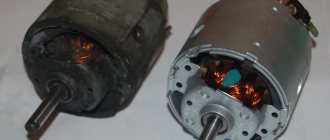Most motorists interested in the design of their car have heard about such a part as an additional heater resistor, but they do not know how it works and what functions it performs. In today's article we will talk about what a VAZ 2114 stove resistor is, where it is located and how to replace it if necessary.
Heater resistor VAZ 2114
Purpose, location and design of the VAZ 2113–15 stove
Unlike classic Zhiguli models, the VAZ 2113–15 stove copes with its duties quite well. If it is in good working order, the inside of the car will always be warm. The air flow distribution system is also implemented quite well, so the windshield, even in severe frost, is completely cleared of ice in a few minutes.
Purpose of the heater
The main function of the stove is to heat the interior and windshield. Hot air supplied through the duct system to the windshield prevents it from freezing in winter. In the warm season, the stove is used for forced ventilation of the interior.
Location and design of the stove
The VAZ 2113–15 stove is located in the front part of the cabin under the center console of the dashboard. Only the heater controls and deflectors through which air flows are brought into the cabin.
The interior heater of the VAZ 2113–15 is closed by the center console
The stove consists of the following elements:
- casing;
- radiator;
- tap;
- inlet and outlet pipes;
- electric motor with a cylindrical impeller;
- windshield defroster;
- control valve;
- foot air damper;
- control module (mode switch, resistor, damper control levers).
Operating principle of the stove
The operation of the stove is based on heat exchange between the heated coolant (coolant) and the air entering the cabin. The basis of the design is the radiator. It is a system of tubes within which heated coolant supplied from the power unit circulates. The tubes are equipped with thin lamellas, allowing for more efficient heat transfer to the air.
The radiator is covered by a casing, which is the body of the stove. On one side there is an electric fan that pumps air into the device. By varying the fan rotation speed with a switch that changes the resistance of a special resistor and located on the central panel, you can regulate the intensity of the air flow entering the cabin.
Circulating between the radiator lamellas, the air heats up and enters the passenger compartment through air ducts located in the front part of the heater. The distribution of flows is carried out using three dampers, one of which (control) regulates (opens or closes) the flow of air into the cabin, and the other two (air blowing for the legs and windshield) change its direction.
The basis of the design of the interior heater is the radiator
The stove can be completely disconnected from the engine cooling system using a tap that shuts off the coolant supply to the radiator of the heating system.
Where is the heater resistor located in a VAZ-2114 car?
During the winter season, when the temperature outside is sub-zero, drivers turn on the stove to heat the interior. At the same time, the heating system on cars, including the VAZ-2114, consists of several components and elements. Accordingly, sometimes some of them fail during operation - for one reason or another. The heater must work normally in winter - driver discomfort behind the wheel often becomes the cause of various types of accidents on the roads. Therefore, there is no need to delay troubleshooting.
Features of the VAZ-2114 heating system
First, let's outline how the “fourteenth” stove works. Everything here is quite simple - exactly the same as on the predecessor of the VAZ-2114 - the “nine”. Here are the main details of the heating system of the “fourteenth”:
- radiator;
- faucet;
- fan;
- switch that regulates air flow.
As you can see, there really is nothing complicated here. Warm air is supplied to the cabin through special dampers. In this case, the power of the fan is controlled using a special resistor. Problems with it lead to the fact that the stove does not work in the first and second positions of the switch.
Due to the design features, the driver in such a situation has to wait quite a long time until the long-awaited heat begins to flow into the car interior.
From 2 spirals with different resistances - 0.23 and 0.82 Ohms. Let's look in a little more detail at what role the designers assigned to this part. So, when the fan is turned on in the first position, current is supplied through both spirals. One more click - and the electricity is already flowing one at a time, with less resistance. If you turn on the fan at third speed, the current will be supplied to the motor directly, bypassing the resistor.
Diagnosis of stove malfunctions
The design of the stove is quite simple. It would seem that there is nothing to break here. The heater cannot break down completely, since its design consists of components independent from each other. However, some elements can fail quite often. These include:
- radiator;
- tap;
- pipes;
- resistor;
- mode switch.
Heater radiator malfunctions
The main reasons for the failure of the stove radiator:
- clogging;
- the appearance of a leak (depressurization).
In the first case, deposits accumulate on the inner walls of the radiator tubes. They can form as a result of:
- long-term operation of the radiator;
- use of low-quality coolant;
- getting dirt, friction products, water, etc. into the cooling system.
As a result, the circulation of antifreeze in the heater radiator is disrupted or completely stopped, and the air entering the cabin does not have time to heat up normally. In winter, it will be cold inside the car, and defrosting the windshield will become a real problem.
A leak in the radiator can appear as a result of corrosion and drying out. Coolant leaking from the heater usually forms a puddle on the floor under the panel on the passenger side. In addition, a characteristic odor will appear in the cabin, and an oily coating will form on the windshield due to evaporation of the coolant, reducing the driver’s visibility. The latter is especially true when driving against the sun or at night, when oncoming traffic is moving with its headlights on.
problem with the heater | Topic started by: Horatio
The heater fan only turns on in position 4, what is the reason?
Albert (Batool) Maxim, the heater motor only works at the maximum straight 4 speed, so that it rotates more slowly, a resistance is applied to it, which takes away a certain amount of electricity and because of it the motor rotates more slowly.
Albert (Batool) Maxim, by the way, if the wires are in place, but the stove does not turn, then this spiral has burned out.
Roman (Siham) change the resistor
Maxim (Farhana) what I found https://www.autosecret.net/lada-granta-vaz2190/kuzov-i..
Roman (Siham) I have another question: the passenger on the right has a cold right leg. Or are there nozzles only near the left leg? Suite with climate control.
Albert (Batool) Roman, I'm sick of these people. who told you that you have climate control? Exactly the same stove, only the numbers were drawn. especially from the official. I asked the dealer what the differences were. the nozzle is only in the center, there are also through holes somewhere on the right, it seems that it is still blowing from there.
Roman (Siham) Albert, I don’t know. I didn’t measure the temperature in the cabin, but it was noticed that at some point cool air blew in. maybe something broke)) who knows. Well, that wasn't the question at all...
Albert (Batool) Roman, let's figure this out to the end. warm up the engine, set it to somewhere around 22-26 degrees and open the door, if more hot air blows from the stove, it means you really have a climate and it is trying to warm up the cooling interior more. and in the same way, drive into a warm garage and notice whether colder air has begun to blow or whether the temperature has risen because the stove heats up warm air in the garage.
Roman (Siham) Albert, no garage. I'll try with the door)
Albert (Batool) Roman, why aren’t there supermarkets with underground parking?
Lyokha (Maurizio) The climate should consume more gasoline.
Roman (Siham) Albert, no
Maxim (Farhana) fixed it, the block of additional resistors has failed, it can be easily changed, the price in Samara is 550 rubles, made in Korea, does not have a catalog number
Repair and replacement of faulty stove elements
It is completely impractical to change the VAZ 2113–15 stove. First of all, this is quite expensive - buying a new stove without a tap and pipes will cost 4-5 thousand rubles. Moreover, replacing the heater is very labor-intensive - you will need to completely remove and then reinstall the panel. The job may take a full day and will require an assistant. It is much easier to identify the faulty element and replace only it.
Restoring the stove radiator
If a stove radiator is clogged from the inside, you can try to clean it of scale and deposits with various household cleaning products, such as Comet, Krot, Silit, or other chemically active substances. Some car owners use Coca-Cola for this purpose.
It is better to carry out the flushing procedure with the radiator removed, but you can do without dismantling it. To do this, drain the coolant from the system, remove the pipes from the radiator and pour a cleaning agent inside. Then the engine starts, the heater turns on and runs for several hours. After this, the radiator is thoroughly washed by connecting a hose with running water to it and dried with compressed air.
In the event of a leak, restoring the radiator is much more difficult. This can be done by soldering. However, most radiators are made of aluminum, damage in which can only be soldered with a powerful soldering iron using special fluxes and solders. But even in this case, there will be no guarantee that the radiator will be fully operational. It is much easier to replace it - a new product for the VAZ 2113-15 costs about a thousand rubles.
Replacing a stove radiator without removing the panel
The VAZ 2113–15 instruction manual states that access to the radiator can only be achieved after dismantling the panel. However, craftsmen came up with an algorithm for replacing the radiator with only partial disconnection of the panel from the body. To do this you will need:
- crosshead screwdriver;
- keys for 7, 10 and 13;
- a container for draining coolant from the cooling system with a volume of at least 5 l;
- a wide and shallow container for draining liquid from the heater radiator;
- dry rags;
- oilcloth or thick polyethylene film.
We check and repair the BA3 2109 stove
Interior heating is an important system, which, if it breaks down, can unexpectedly cause discomfort during the cold season. To prevent this, it is necessary that the 2109 stove is maintained in good condition. You should know how we get warm air into the cabin at the exit. Knowing the principle of operation of the engine cooling system and the electric heating ventilation drive, it is not difficult to repair the VAZ 2109 stove with your own hands.
At first glance, the interior heater seems to be a primitive device. Like, the car is driving towards the air flow, air is sucked in, somehow it is heated, and now it is already warm in the cabin. But it is not so. The stove is an auxiliary radiator for the engine cooling system, and air is pumped into the cabin using an electric drive. Therefore, let’s figure out how the stove receives heat from the cooling system and study its electrical circuit. Knowing this, you can identify malfunctions in the heater. Let's find out how to replace the VAZ 2109 stove fan with your own hands.
Replacement
Changing the resistor is easy. But for this you will have to take several steps.
- Make sure that the problems with the heater on the VAZ-2114 are related precisely to a faulty resistor.
- On the left is your car's dashboard console trim. Remove it to find the failed element.
- Wires are connected to it. They must be removed carefully so as not to damage them. It will not be superfluous to check the integrity of the wiring.
- Unscrew the fastening element. The resistor is held in place by a regular screw, so take a screwdriver with you.
- Remove the old element and check its operation.
- A regular multimeter is suitable for checking. Its presence in the garage or in the car greatly helps car owners when diagnosing and repairing their car. Check the resistor for breaks.
- If there are breaks, then the resistor is unsuitable for use. You need to buy a similar new one and install it in place of the old element.
- Reassemble in reverse order.
There is nothing complicated about the work, so you can do it yourself. This will save you time and money on visiting a service station.
Important! If problems arise in the heating system of the VAZ-2114 regarding the fan, be sure to check the fuse. Always start searching for the causes of malfunctions with the simplest ones, gradually moving towards complex potential causes of breakdowns.
It is quite simple to determine that the cause of the heating failure was not a resistor, but a fuse. It is marked F7 and is responsible not only for the heater fan, but also for the headlight washer motor, glove compartment lighting, cigarette lighter and heated rear window. If these components do not work, the problem can be solved by simply replacing the fuse.
If a resistor failed on your car, be sure to write how you dealt with the problem and how difficult it was to change the element. Share your impressions, leave comments and ask questions. We will definitely answer them.
Features of the system design
The heater and the entire heating system of the VAZ-2114 are in many ways similar to its predecessors. It is considered simple, which makes DIY repair possible.
Main components of the heating system:
- fan,
- stove tap (faucet or switch),
- radiator,
- air flow regulator.
The design is simple. Air is supplied inside the cabin through dampers. The resistor is responsible for the fan power and its operation. If the resistor on the VAZ-2114 stove fails, the regulator in the first and second positions stops working.
Important! If you do not change the element of the heating system and leave everything as is, then warming up the interior will take a very long time. In cold winter conditions, you will not have enough patience and health.
In the VAZ-2114 heating system there are two spirals, the resistance of which is 0.23 and 0.82 Ohms. When the fan is in the first position, current is supplied through two spirals. Switching to the second position allows electricity to flow through one coil, so there is less resistance.
And when the regulator is in the 3rd position, the fan receives current from the motor, that is, bypassing the resistor. So if the stove does not work in the first two positions, then the reason is in this element of the VAZ-2114 heating system.
Nuances and location
To replace a device, you need to know where it is and why it needs to be replaced rather than repaired.
- The designers of the VAZ-2114 did not hide the resistor very far. It is located above the gas pedal. That is, you need to look for the element on the driver’s side. To access the device, you do not need to unscrew or remove anything.
- Its breakdowns are rare. Usually problems appear due to melted tip pads or burnt contacts. To fix the heating, you need to clean the contacts, buy and install a block.
- Experienced VAZ-2114 owners advise always having a new resistor in reserve. It will help you quickly, by elimination, determine the cause of the heating system problem. Not everyone can visually determine whether a resistor has burned out or not. By inserting a new one in place of the old one and checking the operation of the heater, you will see whether it is to blame or whether the problem needs to be looked for in other places.
- Principle of operation. The resistor is used to regulate the speed of the stove. It is needed to create resistance in order to reduce voltage. For the VAZ-2114 there is an element with two resistance spirals. The resistance of the first spiral is 0.23 Ohm, and the resistance of the second spiral is 0.82 Ohm. This allows you to turn on the stove in two operating modes through one resistor.
What is a stove fan
A fan is a functional element that drives air through the heater radiator and into the cabin. The fan, along with the radiator, pipes for refrigerant circulation, liquid regulator and air duct, is part of the heating unit. Its purpose is to drive cold air through a heated radiator, creating heat exchange.
Node functions
The heater fan is a motor that supplies air. You can imagine its operation in more detail only during the operation of the entire heating system:
- As the car engine heats up, liquid enters it, cooling the walls of the cylinder block and taking away heat.
- Hot antifreeze enters the heater radiator, and the latter quickly heats up.
- A motor (fan) is turned on, supplying flows of cold air, thereby cooling the element.
- The interior of the car begins to warm up.
The heating diagram of the VAZ 2113–2115 clearly shows the purpose of the motor
Where is the VAZ 2113-2115 heater motor located?
On VAZ 2113-2115 vehicles, the heater motor is located in the engine compartment. It is covered with a protective casing secured with four screws. The fan itself is also supported by bolts and nuts and is connected to the body of the car.
To gain access to the fan in order to dismantle it, you will have to first work in the interior. In particular, remove the wiring that connects the fan to the vehicle's electrical system.











